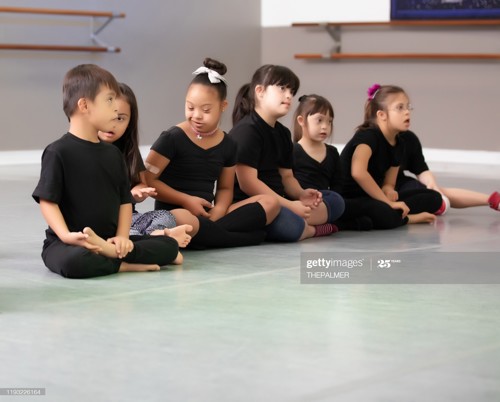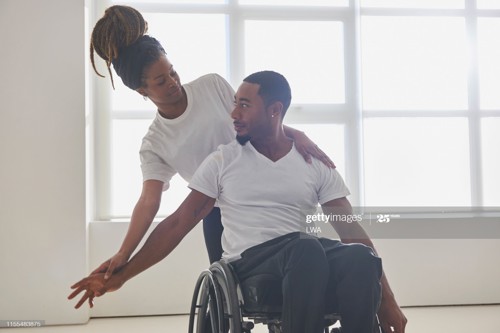Ballet for All – shifting focus to adapt practice
Authors: Clare Guss-West, MA and Irma Becker, BA

More than any other dance form, ballet presents perhaps the greatest challenges to all aspects of accessibility with its prevailing focus on the physical achievement of the form and on conformity to traditional aesthetics and yet the demand for adapted ballet practice is growing fast. Institutions such as the Royal Academy of Dance and the Joffrey Ballet school’s Adaptive dance program embrace such diversity and inclusivity and in many cases, integrate children with motor challenges into regular class. Young Chloé Henderson, the RAD’s first disabled student to pass a syllabus exam reports that when she does ballet she feels like she’s in a world where she is not different (Ship. ITV 2018). Larke Johnson is one of the first Joffrey students with cerebral palsy to dance in their Nutcracker performance last year. Nutcracker Ballet master Suzanne Lopez explains that their objective is they want all people in the audience to feel represented. “Just because we have a disability doesn’t mean we can’t be a normal kid” says Larke (Baca. ABC 2019).
More and more teachers today find themselves addressing a range of physical, mental and attentional challenges amongst students in their hobby ballet classes. Students may be suffering from conditions such as ADHD (Attentional Deficit Hyperactivity Disorder), dyslexia, they may be somewhere on the autism spectrum, with Asperger syndrome, suffering from obesity, with physical challenges such as scoliosis or more severe physical impairment, or with neurodegenerative diseases such as cerebral palsy. Ballet teachers find themselves improvising to provide for huge differentiation in class, having perhaps to incorporate supports, walking devices and wheelchairs without any specific complementary training or knowledge of teaching approaches to facilitate such inclusion. The explosion of dance for older adult learners too brings with it a similar array of diverse age- and health-related challenges that require an adapted approach by the teacher to class planning and delivery. The need to provide adapted, inclusive evidence-based teaching strategies and best practice recommendations to support teachers and facilitate learning and performance is becoming acute.
Perhaps the first thing that needs to shift to be able to adapt ballet for all is the way that we focus on and see ‘difference’: evaluating, separating and addressing dancers based primarily on their physical ability. Bradford Chin, ballet teacher of Axis Dance Company for able and disabled dancers, suggests that every ‘body’ is different, even in what might seem an homogenous group of professional ballet dancers – every movement, if we observe closely, will be executed differently based on physiological variation. All of those tendus are realistically not the same he observes, “Everyone has a different range of turnout, different pointe or plantarflexion, technique is simply different from person to person”. So, a shift in approach would be to take that concept, understand it, and extend its logic to all dancers universally.

A key strategy for teachers of adapted ballet is to present material and concepts in a way that is not body-specific, consciously promoting a focus on the intention or the essence of the movement and deliberately away from a body-specific focus on physical ability and conformity. Teachers might describe the movement intention of a tendu for instance, as reaching, stretching, spiraling, or searching or focus on the smooth quality of the plié or the sharpness of the battement glissé as Irma does when working with the dancers of the Inclusion Theater Project. This focus on the desired movement intention presents a variety of options for the dancer that supports their movement success and gives the freedom to explore and translate the movement intention in their own body, within their own possibilities.
Focusing the attention of dancers on to their movement quality, sensations, patterns or effect, rather than on the self, on the differences of the individual body, encouraging self-consciousness and self-adjustment of the physical form, is a simple, evidence-based strategy that teachers can effectively adopt for all learners and for many pathologies and conditions. The use of an external focus of attention, as it is known, promotes immediate benefits such as: deepening of the breathing, lowering of heart rate, reduction of muscular hypertension, increasing range of motion, improving movement quality and fluidity and promoting automatic micro-adjustment to diminish postural sway and reinforce movement confidence (Wulf 2013). These benefits apply to all ages, all abilities or disability, from the beginner, older adult, dancer in recovery or dancer with physical or neurodegenerative movement challenges or special needs. Research confirms these benefits for such conditions such as ADHD, mild intellectual disabilities, in the case of injury recovery, post-stroke rehabilitation and for neurodegenerative conditions such as Parkinson’s Disease (Landers et al 2005), (Wulf et al 2009), (Fasoli et al 2002), (Chiviacowsky, Wulf & Ávila 2012), (Saemi et al 2013) . Promoting such a shift of attention in teaching is found also to free cognitive reserve, enhancing neuromuscular communication, coordination, reaction time, promoting implicit learning, heightening sensory perception and capacity for musical listening, artistic interpretation and freedom for movement enjoyment (Wulf 2013), (Mornell & Wulf 2019).
Integrating such movement and learning challenges as Down Syndrome, Autism spectrum, Asperger syndrome and quadriplegia into hobby ballet class, Irma observes that ballet prepares the body for efficient movement and opens the mind, developing cognitive functioning to facilitate learning. She reminds us that it’s important when teaching adapted ballet to consider that chronological age is not the same as developmental age and that the most appropriate approach will depend a lot on the umbrella of disabilities. The use of imagery therefore is another foundational teaching tool that also promotes an external attentional focus and therefore all of the associated benefits. Irma’s students enjoy devising shapes and forms and funny images for the ballet vocabulary themselves that facilitate their learning and recall – such as holding a big beach ball for 1st position arms or thinking of their first position feet like a generous pizza slice. One of the advantages of using imagery as a teaching tool is its capacity to unite a class. All dancers can imagine however global their physical movement challenges.

Inclusive Theater Project. Dancer Gray Rubin, ©ASC ITP Peter Pan Production.
A sense of inclusion and equality is promoted through the systematic use of such an external attentional focus on the movement. This might consist of a focus on the qualities, sensations and intentions of the movement or a focus on the musicality or on partner dancers or might involve exploring the movement through creative imagery and story as both Bradford and Irma describe in their practices. As we approach movement with a unifying external focus of attention, all dancers come together with a common intention, rather than experiencing the acute sense of ‘difference’ and separation that is constantly reinforced when we focus on the physical form and the need for physical conformity. At the same time, this simple holistic shift of our teaching focus away from the physical differences and onto the desired movement, does paradoxically promote optimum movement efficiency and effectiveness and enhance mental and perceptual functioning for all learners, not only those with movement and learning challenges – providing a single, simple teaching strategy capable of unifying any diverse class.
Clare Guss-West is Chair of IADMS Dance for Health committee and international teaching artist and teacher trainer at Bern University, Université Côte d’Azur and the Royal Academy of Dance specializing in attention and focus in dance and adaptive dance practice for senior populations.
Irma Becker is coordinator of the Inclusion Theater Project, Area Stage Company, Miami Florida, and CPD tutor of the Royal Academy of dance specializing in ballet and disability.
Recommended Further Reading and Resources
Baca, Stacey. 2019. ABC. November 27th. Accessed 26.11.2020: https://abc7chicago.com/joffrey-ballet-the-nutcracker-chicago-emma-lookatch/5722859/
Candoco. 2019. Student Resource Pack. Accessed 25.11.2020: https://candoco.co.uk/wp-content/uploads/2019/10/FINAL_Candoco_Student_Resource_Pack.pdf
Chin, Bradford. 2020. Axis Dance Company, CA. Personal Communication 6th July. Chiviacowsky, Suzete, Gabriele Wulf, & Luciana Ávila. (2012). An external focus of attention enhances motor learning in children with intellectual disabilities. Journal of Intellectual Disability Research, doi: 10.1111/j.1365-2788.2012.01569.x.
Guss-West, Clare. 2021. Attention and focus in dance. Champaign, IL: Human Kinetics.
Guss-West, Clare 2020. Attention Unites – Ability Divides: using mindful attentional focus techniques to enable access to ballet for all. IADMS i-conference. Accessed 25.11.2020: https://www.youtube.com/watch?v=BVdFLoInseE&feature=youtu.be
Guss-West, Clare 2018. Optimal Focus – From research to dance practice. IADMS Blog. www.iadms.org Guss-West, Clare and Gabriele Wulf. 2016. “Attentional Focus in Classical Ballet: A Survey of Professional Dancers”, Journal of Dance Medicine & Science 20.1: 23-29.
Fasoli, Susan, Catherine Trombly, Linda Tickle-Degnen, & Mieke Verfaellie. 2002. Effects of instructions on functional reach in persons with and without cerebrovascular accident. The American Journal of Occupational Therapy, 56, 380-390.
Landers, Merrill, Gabriele Wulf, Harvey Wallmann, & Mark Guadagnoli. 2005. An external focus of attention attenuates balance impairment in Parkinson’s disease. Physiotherapy, 91, 152-185.
Mornell, Adina and Gabriele Wulf. 2019. Adopting an External Focus of Attention Enhances Musical Performance. Journal of Research in Music Education, 66(4):375-391. doi:10.1177/0022429418801573
Redding, Emma and Imogen J. Aujla. 2013. “Barriers to dance training for young people with disabilities”. British Journal of Special Education 40.2
Saemi, Esmaeel, Jared Porter, Gabriele Wulf, Ahmed Ghotbi-Varzaneh, & Sabah Bakhtiari. 2013. Adopting an external focus of attention facilitates motor learning in children with attention deficit hyperactivity disorder. Kinesiology, 45, 155-165.
Ship, Chris. 2018. ITV. September 4th. Accessed 26.11.2020: https://www.itv.com/news/2018-09-04/10-year-old-chloe-henderson-becomes-first-disabled-child-to-pass-pre-primary-ballet-exams/
Wulf, Gabriele. 2007. Attention and motor skills learning. Champaign, IL: Human Kinetics.
Wulf, Gabriele, Merrill Landers, Rebecca Lewthwaite, & Thomas Töllner. 2009. External focus instructions reduce postural instability in individuals with Parkinson disease. Physical Therapy, 89, 162-168.
Wulf, Gabriele. 2013. “Attentional focus and motor learning: A review of 15 years.” International Review of Sport and Exercise Psychology. 6:77-104